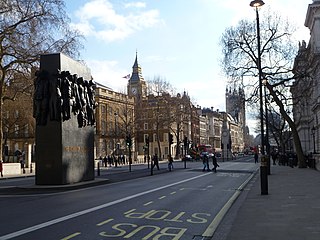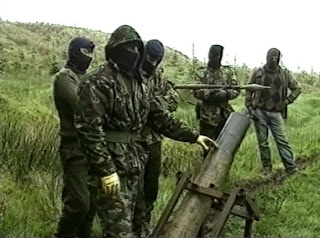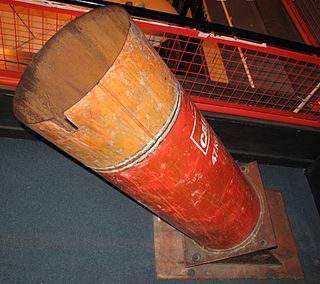The Real Irish Republican Army, or Real IRA (RIRA), was a dissident Irish republican paramilitary group that aimed to bring about a United Ireland. It was formed in 1997 following a split in the Provisional IRA by dissident members, who rejected the IRA's ceasefire that year. Like the Provisional IRA before it, the Real IRA saw itself as the only rightful successor to the original Irish Republican Army and styled itself as simply "the Irish Republican Army" in English or Óglaigh na hÉireann in Irish. It was an illegal organisation in the Republic of Ireland and designated a proscribed terrorist organisation in the United Kingdom and the United States.

Whitehall is a road and area in the City of Westminster, Central London, England. The road forms the first part of the A3212 road from Trafalgar Square to Chelsea. It is the main thoroughfare running south from Trafalgar Square towards Parliament Square. The street is recognised as the centre of the Government of the United Kingdom and is lined with numerous departments and ministries, including the Ministry of Defence, Horse Guards and the Cabinet Office. Consequently, the name "Whitehall" is used as a metonym for the British civil service and government, and as the geographic name for the surrounding area.

The East Tyrone Brigade of the Provisional Irish Republican Army (IRA), also known as the Tyrone/Monaghan Brigade was one of the most active republican paramilitary groups in Northern Ireland during "the Troubles". It is believed to have drawn its membership from across the eastern side of County Tyrone as well as north County Monaghan and south County Londonderry.

From 1969 until 1997, the Provisional Irish Republican Army (IRA) conducted an armed paramilitary campaign primarily in Northern Ireland and England, aimed at ending British rule in Northern Ireland in order to create a united Ireland.

The London Docklands bombing occurred on 9 February 1996, when the Provisional Irish Republican Army (IRA) detonated a powerful truck bomb in South Quay. The blast killed two people and devastated a wide area, causing an estimated £150 million worth of damage. The IRA had sent warnings 90 minutes beforehand, but the area was not fully evacuated. As well as the two people who were killed, more than 100 were injured, some permanently.

Barrack buster is the colloquial name given to several improvised mortars, developed in the 1990s by the engineering unit of the Provisional Irish Republican Army (IRA).
This is a chronology of activities by the Continuity Irish Republican Army (CIRA), an Irish republican paramilitary group. The group started operations in 1994, after the Provisional Irish Republican Army began a ceasefire.
On 28 February 1985, the Provisional Irish Republican Army (IRA) launched a heavy mortar attack on the Royal Ulster Constabulary (RUC) base at Corry Square in Newry, County Down, Northern Ireland. The attack killed nine RUC officers and injured almost 40 others; the highest death toll ever suffered by the RUC. Afterwards, a major building scheme was begun to give police and military bases better protection from such attacks.
This is a timeline of actions by the Irish republican paramilitary groups referred to as the Real Irish Republican Army and New Irish Republican Army. The Real IRA was formed in 1997 by disaffected members of the Provisional IRA. Since July 2012, when Republican Action Against Drugs (RAAD) and other small republican groups merged with it, the group has been called the New IRA; although it continues to call itself simply "the Irish Republican Army".
This is a chronology of activities by the Provisional Irish Republican Army (IRA) from 1980 to 1989. For actions before and after this period see Chronology of Provisional Irish Republican Army actions.
This is a chronology of activities by the Provisional Irish Republican Army (IRA), from 1992 to 1999.

The Osnabrück mortar attack was an improvised mortar attack carried out by a Provisional Irish Republican Army (IRA) unit based in mainland Europe on 28 June 1996 against the British Army's Quebec Barracks at Osnabrück Garrison near Osnabrück, Germany.

On 19 March 1994, a British Army Lynx helicopter was shot down by the Provisional Irish Republican Army (IRA) in Northern Ireland. A unit of the IRA's South Armagh Brigade fired a heavy improvised mortar at the British Army base in Crossmaglen, County Armagh. The mortar round hit and shot down the helicopter, serial number ZD275, while it was hovering over the helipad. Three British soldiers and a Royal Ulster Constabulary (RUC) member were wounded.
On Wednesday 20 September 2000, the Real Irish Republican Army (RIRA) carried out an attack on MI6's SIS Building headquarters in Vauxhall, Lambeth, London. A Russian-built RPG-22 anti-tank rocket, fired 300 metres away from MI6 headquarters, struck the building on the south side of the eighth floor, causing superficial damage. No fatalities or injuries were recorded.
The 1994 Heathrow mortar attacks were a series of homemade mortar bomb attacks targeted at Heathrow Airport carried out by the Provisional IRA. Over a five-day period, Heathrow was targeted three times by the IRA, which fired 12 mortar rounds. Heathrow was a symbolic target due to its importance to the United Kingdom's economy, and much disruption was caused when areas of the airport were closed over the period due to the IRA attacks. The gravity of the incident was heightened by the fact that Queen Elizabeth II was being flown back to Heathrow by the RAF on 10 March.
On 12 October 1992, the Provisional Irish Republican Army (IRA) detonated a bomb that had been planted in the gents' toilets in the Sussex Arms pub in Upper St Martins Lane near Long Acre, London, killing a man and injuring seven other people.

Throughout the protracted conflict in Northern Ireland (1960s-1998), the Provisional IRA developed a series of improvised mortars to attack British Army and Royal Ulster Constabulary (RUC) security bases. The organisation also purchased both light and heavy machine guns in order to hamper the British Army supply of border bases by helicopter. The IRA fitted vehicles, specially vans and trucks, with both types of weapons. Vans, trucks and tractors were modified to transport concealed improvised mortars to a launch area near the intended target and fire them, while light and heavy trucks were employed as firing platforms mounting machine guns, particularly M60s and DShKs. Improvised armoured vehicles and heavy equipment were also used to penetrate the perimeter of fortified security bases. The IRA vehicles were often disguised as belonging to civilian companies or even government agencies.
This is a chronology of activities by the Provisional Irish Republican Army (IRA), in 1990 and 1991.











